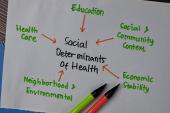One in Three Premature CV Deaths in Young Adults Tied to Social Vulnerability
Efforts must be made to identify and address social determinants of health to see reductions in CV mortality, says Khurram Nasir.

More than one-third of potentially preventable cardiovascular deaths in young adults in the United States are related to increased county-level social vulnerability—in terms of socioeconomic status, household structure, and disability—with non-Hispanic Black individuals and women at the greatest risk, according to new data.
The study piggybacks off previous research showing that people who live in US counties with greater social vulnerability have a greater risk of prematurely dying from cardiovascular disease.
“These findings suggest that racism, but ‘not the race,’ which is linked to unequal resource distribution, is thus a crucial social determinant of health that generates a disproportionate impact on the cardiovascular survival of young minorities,” write lead author Safi U. Khan, MD (Houston Methodist DeBakey Heart & Vascular Center, TX), and colleagues in a research letter published online yesterday in JACC: Advances.
While many studies have shown a link between worse cardiovascular outcomes and community factors like food insecurity and other social determinants of health, senior author Khurram Nasir, MD, MPH (Houston Methodist DeBakey Heart & Vascular Center, TX), told TCTMD that now is the time for something to be done. “There is a huge realization that status quo is not acceptable,” he said. “Just focusing on medical care and risk factors will not achieve our goals. And until we acknowledge, identify, and create pathways for addressing social determinants of health, we may not be able to overcome the growing disparate burden in these vulnerable populations.”
SVI Augments Risk Most for Women, Black Individuals
For the study, the authors used data from the Centers for Disease Control and Prevention Social Vulnerability Index (SVI) from 2014 to 2018, a metric provides information on 15 social variables to define quartiles of vulnerability. They then applied those definitions to cardiovascular deaths of adults aged 18-44 over the same time period as recorded by the National Center for Health Statistics and US Census Bureau. The authors defined potentially preventable deaths as those above what would be anticipated if the death rates in all states were equivalent to the average of three states with the lowest death rates.
Overall, 94,407 CV deaths were recorded on average annually between 2014 and 2018, including 28,842 from ischemic heart disease, 12,272 from stroke, and 2,967 from heart failure. Of these, 38,004 were deemed to be potentially preventable, including 9,480 ischemic heart disease, 3,746 stroke, and 1,900 heart failure deaths.
The highest rates of potentially preventable deaths were observed in men compared with women (51% vs 16%), non-Hispanic Black compared with non-Hispanic white individuals (66% vs 26%), and in adults from nonmetropolitan compared with metropolitan counties (51% vs 32%).
Researchers noted a stepwise increase in potentially preventable CV deaths ranging from the least to the most vulnerable counties as defined by SVI, and this was consistent across demographic groups. Specifically, they found a 35% absolute increase in these deaths—32% for ischemic heart disease, 45% for stroke, and 4% for heart failure—between counties in the fourth versus first SVI quartiles.
Within the SVI, socioeconomic and household composition as well as disability were significantly associated with potentially preventable deaths. Similarly, ischemic heart disease death and nonmetropolitan county residence substantially increased the likelihood of these deaths alongside SVI.
Finally, when looking at the increases in potentially preventable death rates between first and fourth SVI quartiles, women and non-Hispanic Black adults had the highest disparity. For example, while non-Hispanic white men and women reported eight- and 55-fold increases in potentially preventable CV deaths between quartiles, non-Hispanic Black men and women saw 32- and 147-fold increases, respectively. These patterns were maintained across the spectrum of socioeconomic and household composition and disability vulnerability indices.
Just focusing on medical care and risk factors will not achieve our goals. Khurram Nasir
Nasir acknowledged that these are unadjusted analyses that weren’t able to capture individual issues related to dependent care, food access, and transportation, for example, but specified the results “clearly flag” these vulnerable populations. “What it shows us is that racial disparities do not exist in silos,” he said. “There are these underserved racial groups, especially non-Hispanic Blacks and women, who experience multiple interconnected unfavorable social and environmental conditions that clearly not only put them at risk of developing cardiovascular disease, but also reducing their life expectancy.”
Nasir called for the healthcare community to better address “upstream drivers of mortality risk” to reduce inequities in the US. One way to go about doing so would be for “safety net hospitals,” who take care of the majority of high-risk younger individuals in socially vulnerable counties, to “lead the charge,” he said. “They [should] start assessing these factors [and] consider social determinants of health as an important piece in their healthcare delivery, and not only for the patients they are seeing in the clinics, but those in the hospitals and working with local authorities.”
Using a polysocial risk score to screen for SVI at the individual level can be a good start, Nasir suggested.
“The whole idea that we are trying to illuminate here is that we cannot ignore the important and critical role of social determinants of health,” he concluded. “What we need is unity and bringing everyone on the table so that we can all do it together. Because if we keep doing the same thing, which we are doing, truly it will not address the rising burden in the young individuals, which is largely driven by vulnerabilities in their social determinants.”
Yael L. Maxwell is Senior Medical Journalist for TCTMD and Section Editor of TCTMD's Fellows Forum. She served as the inaugural…
Read Full BioSources
Khan SU, Kumar P, Arshad A, et al. Social vulnerability and potentially preventable cardiovascular deaths among younger adults in the US counties, 2014 to 2018. JACC Adv. 2023;Epub ahead of print.
Disclosures
- Khan and Nasir report no relevant conflicts of interest.





Comments